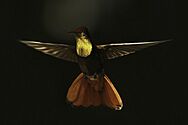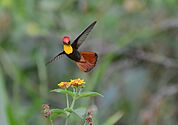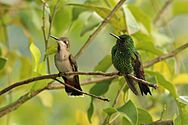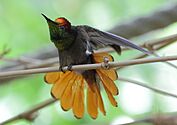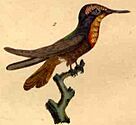Ruby-topaz hummingbird facts for kids
Quick facts for kids Ruby-topaz hummingbird |
|
|---|---|
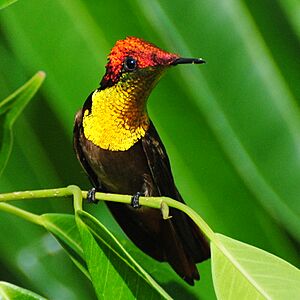 |
|
| In Bonaire | |
| Conservation status | |
| Scientific classification | |
| Genus: |
Chrysolampis
|
| Species: |
mosquitus
|
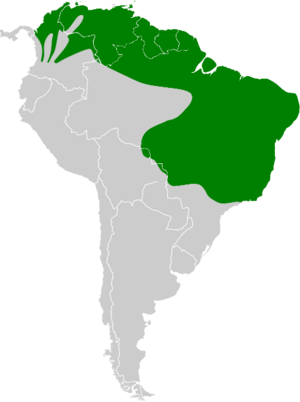 |
|
| Synonyms | |
|
Trochilus mosquitus (protonym) |
|
The ruby-topaz hummingbird (Chrysolampis mosquitus) is a beautiful and colorful species of hummingbird. It is often called simply the ruby topaz. This tiny bird lives in many countries across South America and the Caribbean. You can find it in places like Aruba, Brazil, Colombia, Trinidad and Tobago, and Venezuela.
Contents
About the Ruby-Topaz Hummingbird
Naming the Bird
The ruby-topaz hummingbird was first officially described in 1758. A Swedish scientist named Carl Linnaeus gave it the name Trochilus mosquitus. Later, in 1831, a German zoologist named Friedrich Boie placed it in its own special group, or genus, called Chrysolampis.
The name Chrysolampis comes from an old Greek word. It means "glow-worm," probably because of the bird's shiny, bright colors. The second part of its name, mosquitus, is a Spanish word. It means "little fly," which makes sense for such a small, fast-flying bird! This hummingbird is the only species in its genus. This means it is quite unique.
What Does It Look Like?
The ruby-topaz hummingbird is a small bird. It is about 8 to 9.5 centimeters (3 to 3.7 inches) long. It weighs only about 2.5 to 5 grams (0.09 to 0.18 ounces). Its beak is black and quite short compared to other hummingbirds.
The male ruby-topaz hummingbird is very striking. Its upper body is dark brown with a hint of olive green. Its head and neck are a bright, shiny ruby red. The throat and chest glow with a golden color, but sometimes they can look emerald green. The rest of its belly is brown, and its tail is chestnut brown with black tips.
The female ruby-topaz hummingbird looks a bit different. Her upper body is bronze-green. Her belly is a pale gray. Her tail is mostly chestnut with a dark band and white tips. The feathers in the middle of her tail are olive green. Young females look similar to adult females. Young males look like young females but have some shiny orange on their throats.
Where Does It Live?
The ruby-topaz hummingbird lives in many parts of South America. Its range stretches from eastern Panama all the way to northeastern Brazil. You can also find it in the ABC Islands and Trinidad and Tobago. Sometimes, it has been seen in places like Argentina and Peru.
These hummingbirds like open areas. They live in savannas, which are grassy plains with scattered trees. They also like shrubby hillsides that are dry. You can often spot them in gardens and farms too. They usually live below 500 meters (1,640 feet) in elevation. However, they can sometimes be found as high as 1,700 meters (5,577 feet).
Ruby-Topaz Hummingbird Behavior
How They Move Around
The ruby-topaz hummingbird is a migratory bird. This means it moves from one place to another at different times of the year. The exact timing and path of their movements can change. They seem to move north and south in Brazil. They also travel east and west along the northern coast of South America and its nearby islands.
What They Eat
Ruby-topaz hummingbirds mostly eat nectar. Nectar is a sweet liquid found in flowers. They visit many different kinds of flowers, including those on shrubs, trees, and cacti. They especially like the flowers of the samaan tree and the Ixora plant. These flowers have a lot of sugar, which gives the birds energy.
Male hummingbirds often protect their favorite feeding spots. They don't just eat nectar. They also catch small insects and spiders while flying. Sometimes, they pick insects off leaves.
Life Cycle and Reproduction
The breeding season for ruby-topaz hummingbirds varies. In the northern parts of their range, they breed from December to June. In Brazil, it's usually from September to March.
The female hummingbird builds a tiny, cup-shaped nest. She uses fine plant fibers and spider silk. She often decorates the outside with small pieces of lichen. She places her nest on a branch or in a fork of a branch. Nests are usually between 1 and 4 meters (3 to 13 feet) above the ground.
A female usually lays two eggs. The eggs hatch after about 15 to 16 days. The young birds stay in the nest for about 19 to 22 days after hatching. Sometimes, they might stay a bit longer, up to 28 days, before they are ready to fly.
Their Song
The ruby-topaz hummingbird has a special song. It sounds like a doubled "tliii...tliii...tliii." They usually sing this song from a high spot, like a tree branch.
Status of the Ruby-Topaz Hummingbird
The IUCN (International Union for Conservation of Nature) has looked at the ruby-topaz hummingbird. They have listed it as a species of "Least Concern." This means that it is not currently in danger of disappearing. We don't know exactly how many of these birds there are, or if their numbers are growing or shrinking. However, they are common in lowlands and coastal areas. They also seem to do well in places changed by humans, like gardens.
Gallery



